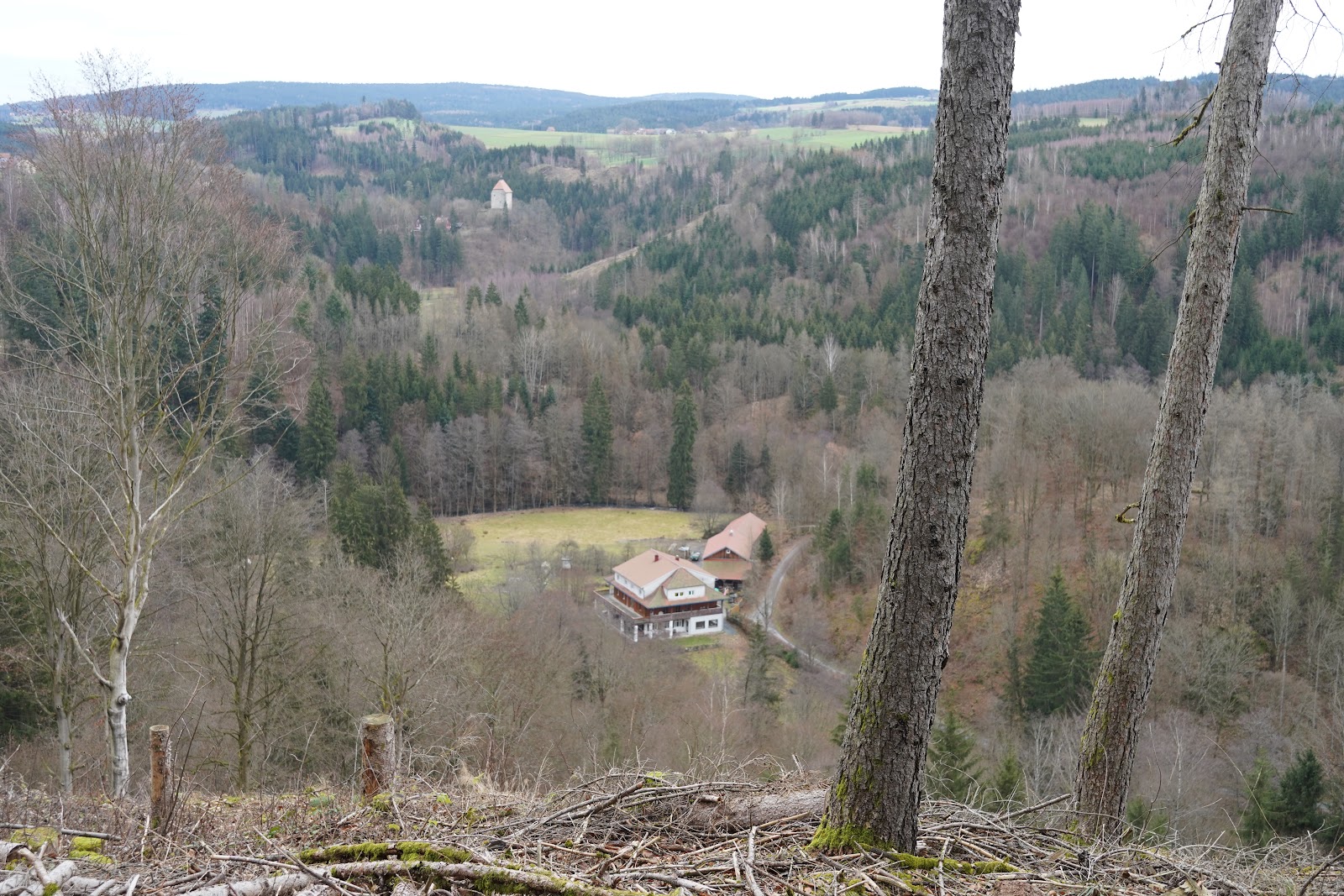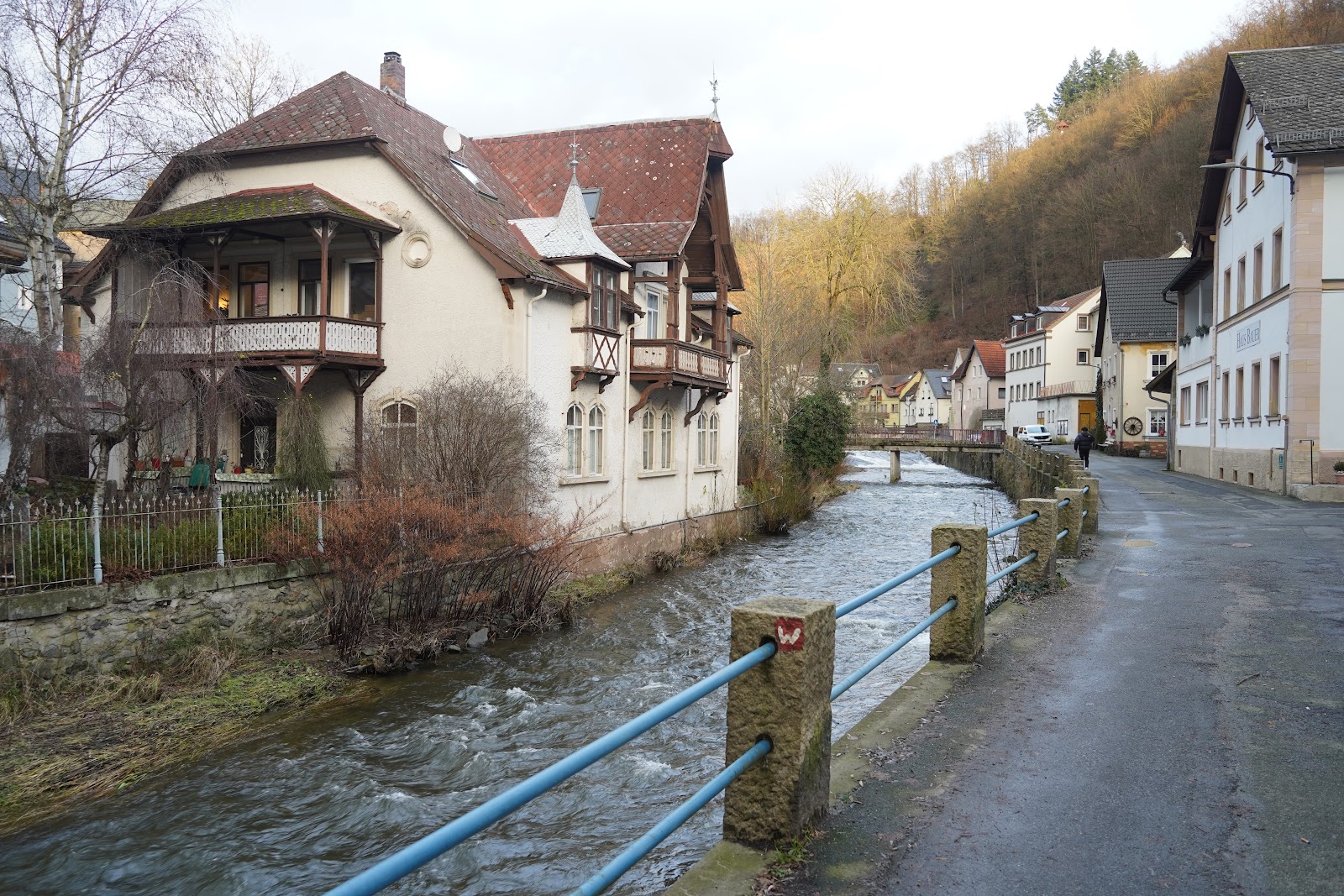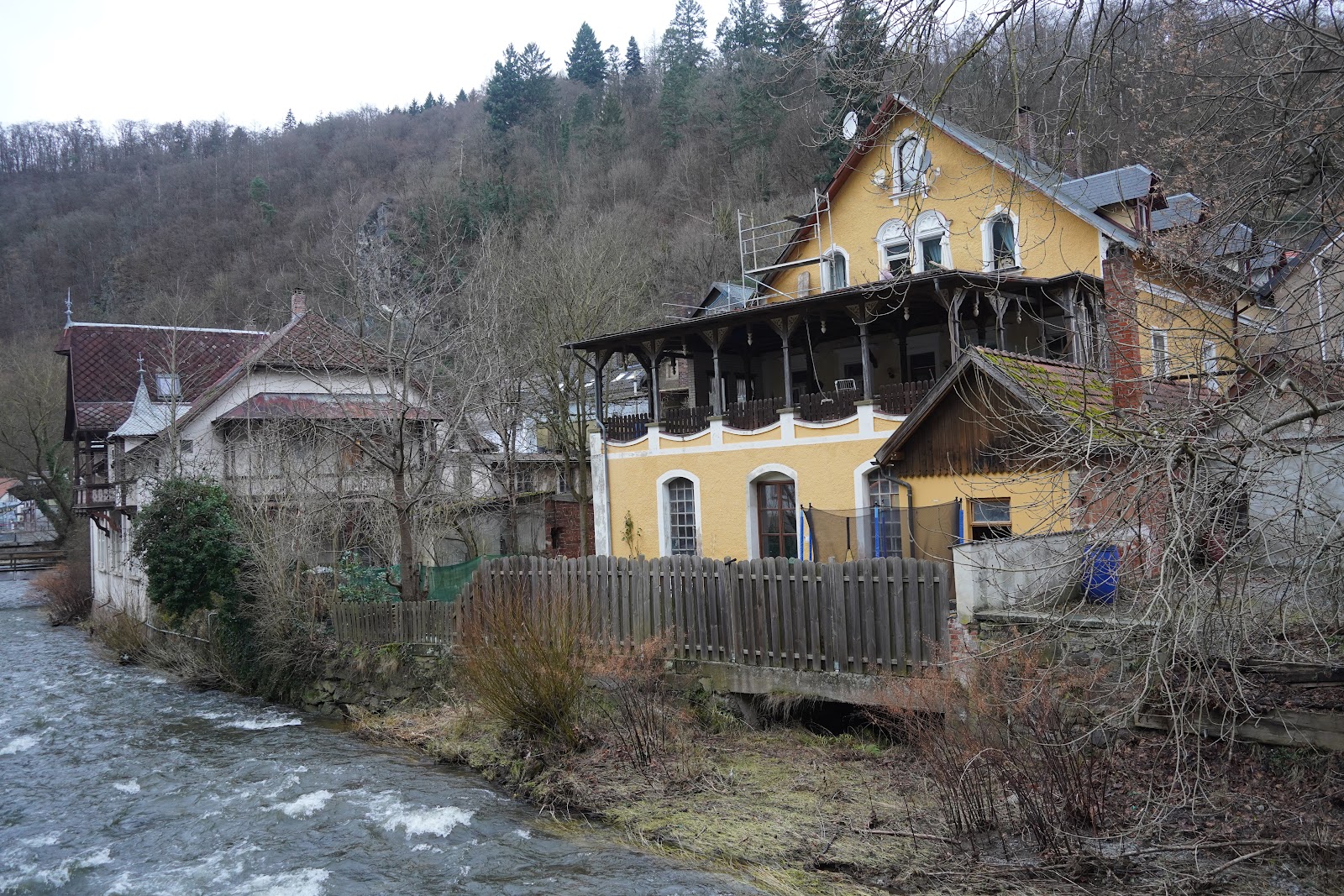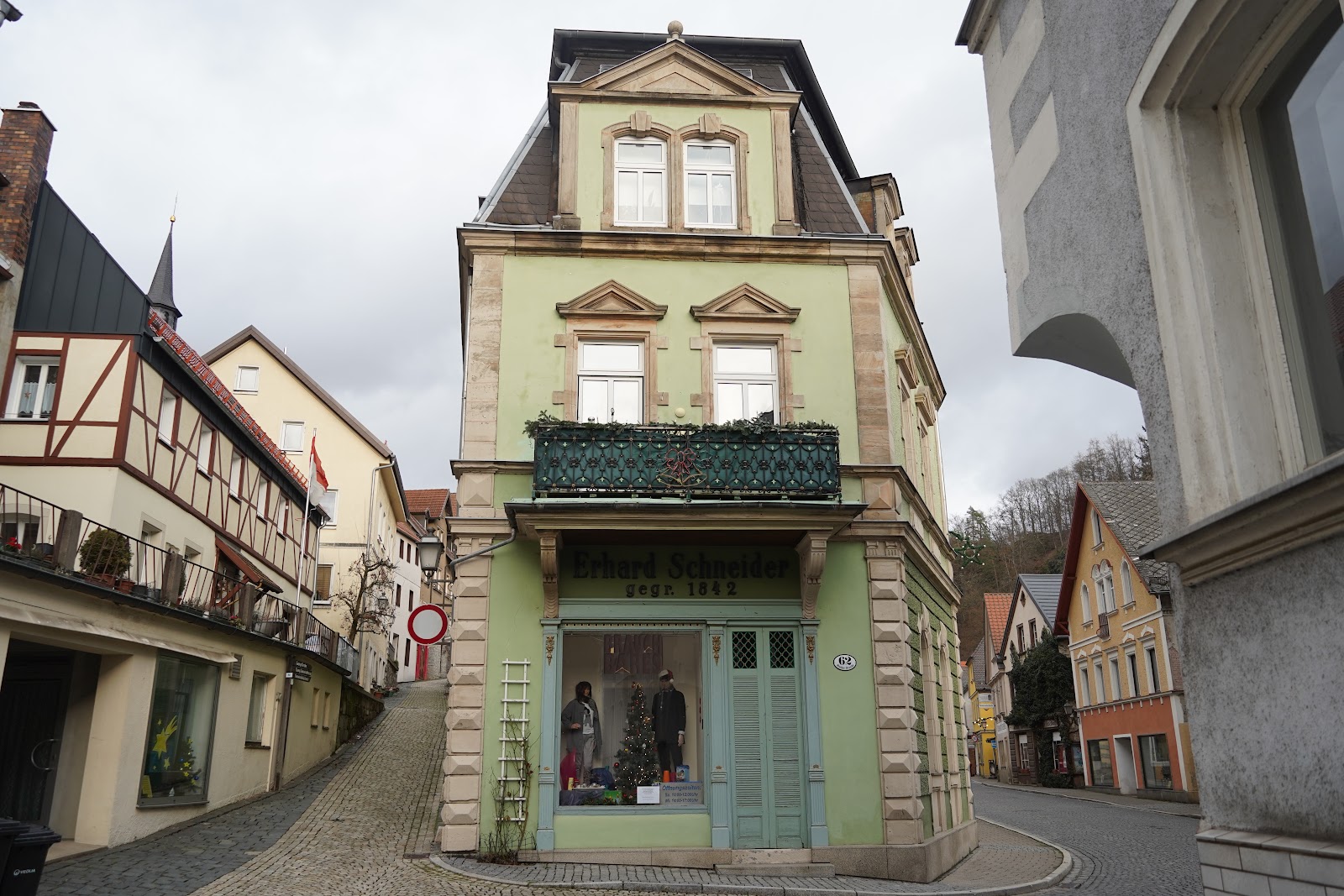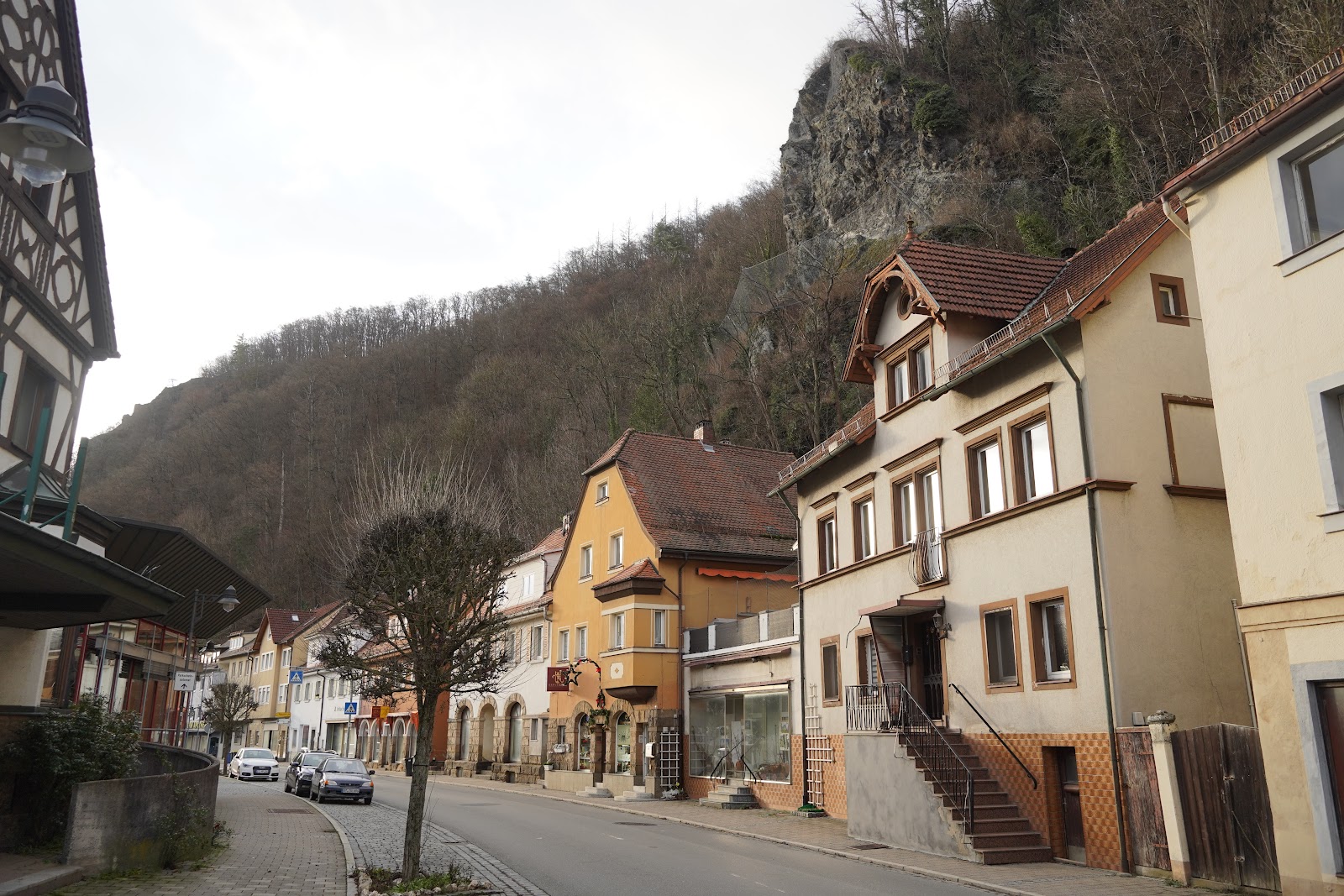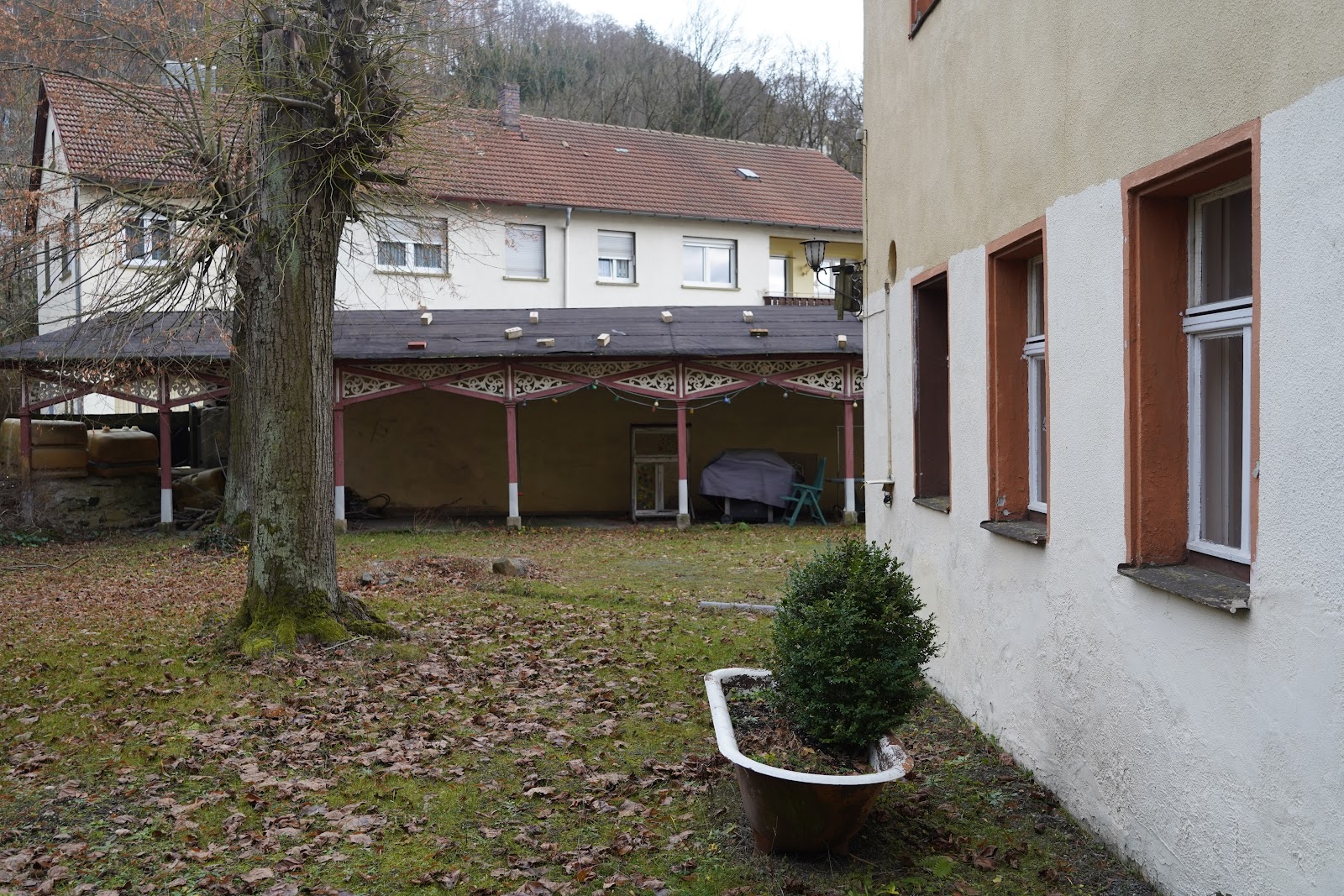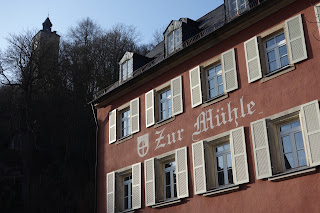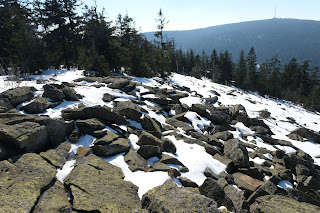Bad Berneck
At none of the tables next to us in the Italian restaurant do I hear the area's original Franconian dialect. Danish is spoken to the left and English to the right. Another group clearly comes from somewhere in northern Germany. Travelers are staying here on their way to or from the south. During the ski season and in summer, the hotels here benefit from travelers passing through. The motorway is not far and the Fichtelgebirge is roughly halfway between Berlin and Innsbruck. After one night most of them leave again.
The market square of Bad Berneck. The fountain is decorated for Easter
Things used to be different here. For visitors from Berlin, the Fichtelgebirge was the first port of call after they had crossed the Iron Curtain on the transit highway to the south. The area was also accessible for weekend trips and there were many Berliners who had bought a holiday apartment or holiday home here.
The continuation of the Via Imperii from Berneck towards the north began here. The view of the church is made easier because a few buildings have been demolished and replaced with parking spaces
The mountains are not far from Bayreuth. During their Wagner Festival in summer it is almost impossible to find accommodate there. Some people have to move to the surrounding area because of the prices. The town of Bad Berneck was particularly popular because of its beauty. The Hotel Bube, the most prominent local hotel, had a reputation known far afield, It saw illustrious guests such as Edward, 2nd Duke of Kent, Krupp General Director Berthold Beitz, Prof. Willy Messerschmitt, Wolfgang Wagner, William Somerset Maugham, Begum Aga Khan, Prince Pierre de Monaco, Hans -Dietrich Genscher or Theodor Heuss. The fact that Adolf Hitler also spent the night here several times during the festival is something they don't want to make a big deal about today. But it shows what reputation the hotel had at the time.
Faded map on the facade of the old post office and former city museum, reminiscent of Via Imperii
The importance of Berneck as a stopover for travelers began in the early Middle Ages. The most important trade route from the Mediterranean to the Baltic Sea, the Via Imperii, has to overcome the climb from the Main valley to the heights of the Fichtelgebirge and Franconian Forest here in the Knodental. After a tower castle that was probably built around 1000 AD Ulrich II Walpot built a castle in 1168 where Hohenberneck Castle now stands. These Walpoden were representatives or ministerials of the rulers who were entrusted with judicial, police and government functions. The next Walpotenburg was just a few kilometers away, on a mountain spur, Stein Castle.
The remains of the Walpoten's first tower castle from the 11th century
Incline of the Via Imperii below the old castle with medieval beer cellars
The Walpoten were replaced by the Andecks-Meranians. The Walpoten castle was probably not good enough for them or the road was relocated. This is how they built what is now known as the Old Castle. Remains of this castle still exist and are used as a festival venue. The original keep was later expanded into a bell tower, which today stands as a landmark over the city.
Access gate to the old castle
After 1248 the Counts of Orlamünde ruled. In 1340 the Burgraves of Nuremberg from the House of Zollern inherited the area from the Andechs-Meranians. The respective owners had to take care of security on the important trade route. In return they received income from customs duties and escort money.
The keep of the old castle, which was later extended into a bell tower
At those times thieves and robbers were lying in wait for the rich merchants everywhere. The name Böseneck of a district of the neighboring towsn Gefrees is still a reminder that the traders on this corner of the road were regularly attacked.
Ruins of the fortified Marienkapelle
In the meantime, the Bishop of Bamberg, who was in competition with the Zoller burgraves of Nuremberg, had taken over Stein Castle. But a bit further on in Gefrees was Grünstein Castle. Not much more than a wall remains today. This castle again was in the fiefdom of the Burgrave of Nuremberg. The traders therefore had to pay the burgrave and the bishop for their services. Stein later fell to the Sparneck family, who also joined the Burgrave of Nuremberg in the middle of the 14th century.
Castle Stein
Remains of Grünstein castle in Gefrees
Böseneck, a place feared by merchants
Already under the Andechs-Meranians, the noble Wallenrode family provided ministeriale. When the lands of the Andechs-Meranians were inherited by the Hohenzollerns, the family took on this role at Berneck Castle, which at that time consisted of the Old Castle. Around 1478, Veit von Wallenrode began building a new castle, Hohenberneck Castle, on the remains of the first Walpoten Castle in Berneck. The old castle next to it was abandoned after its completion, which Veit himself did not live to see. The von Wallenrode family lived in the area until 1739. The Franconian line died out with Karl Friedrich von Wallenrode on September 30, 1739. The castle already had been useless since 1557 and had been uninhabited since 1692 at the latest, when most of Berneck, except for just 5 houses, fell victim to a fire.
The castle Hohenberneck before its recent renovation
... and afterwards
Above Bad Berneck there are the ruins of three castles, namely the original tower castle of the Walpoten, the old fortress of the Andechs-Meranians and early Wallenroders and the Hohenberneck Castle of the Wallenroders. There are also the ruins of a fortified chapel, the Marienkapelle, which was also built by Veit von Wallenrode in the 15th century. On the other side of the Knodental there are still remains of a Celtic rampart, but nothing is known about them.
View from the height above Hohenberneck up the valley to Stein Castle. In the valley is the former Waldschänke excursion cafe
Short-term transit travelers are probably little aware of all of these historical turmoil typical of the German region. They want to go south, either to a ski paradise without snow or to a beach where it is almost unbearable in summer because of the increasing temperatures. And if you're interested in history, you'll probably be more interested in the Cathar castles of southern France, the ornate architecture of Tuscan Renaissance cities, or the castles of Scottish nobles.
The hike on the Thiesenring around Berneck opens up this view of the city, the old castle and Hohenberneck Castle. The viewing pavilion has survived from Berneck's wedding
This is not due to the efforts of the local authorities. Every remnant of the wall is well explained with display boards, Hohenberneck Castle was recently extensively restored and the city received an award for its QR code-based historical hike. However, the financial possibilities were exhausted. The gate of the restored castle is locked. The QR code app is no longer supported because it costs too much. The tower of the old fortress, which offers a fantastic view, is usually inaccessible. And the city museum in the listed old post office has been closed since time immemorial.
The beauty of Bad Berneck was mentioned as early as 1793 in a letter from Friedrich Wilhelm Wackenroder (1773-1798) and Wilhelm Tieck (1773-1853) during their Pentecost trip: “Just before Berneck you are surprised by a sight that is one of the most beautiful that there is We had.” At the same time, the wandering, but unfortunately completely illegible, scribe Johann Paul Friedrich Richter (1763-1825), better known by his pseudonym Jean Paul, also often came by here.
At the other end of the Thiesenring there is this view of the White Main valley upstream. On the slope opposite is the abandoned Siemens rest home
“In Berneck they spent the night between the high pillars of mountains, between which the seas that have covered our sphere with regions flowed. Time and nature rested great and all-powerful next to each other on the borders of their two kingdoms - between steep, high memorial pillars of creation, between solid mountains the empty mountain castles crumbled, and around round green hills lay rock bars and stone clods, as if they were shattered Tables of the law of the first formation of the earth.” (Jean Paul)
View of the old castle from the market square
View from the river bank to Hohenberneck Castle
Historic buildings in the town center

After the fire of 1692, the rebuilt town slowly expanded from its center around the Trinity Church, built on a saddle in the Ölschnitz valley, and the market square into the narrow valleys of the waters falling from the mountain towards the Main Valley. Seven of them they count proudly, in addition to the Weisser Main and the Ölschnitz, the Knodenbach, the Rimlasgrundbach, the Bärnreuther Graben, the Heinersreuther Bach and the Heinersreuther Bächlein. In the narrow valleys, the houses are built right up to the formidable rocks of, it's hard to believe, seven mountains that tower above the town. The forest hangs on the steep slopes above the roofs. If you stand somewhere up there, you have a wide view over the meadows with small villages and lonely farms that seem to be just a stone's throw away. In reality, however, they are separated from the viewer by deep valleys whose steep slopes can only be overcome via sweat-inducing or knee-destroying zigzag paths. In between are the streams, which turn into rushing floods when it rains in winter.

The torrential Ölschnitz forms the center of the city center
On the left is the Hotel Bube, and former guesthouses on the banks
The old guesthouses had picturesque balconies for the guest rooms

In the background the former spa building
“You drive between high mountains into a narrow valley, where the town is squeezed into a narrow space. The black, pointed church tower rises above the city. Next to it, the bolder tower of an old castle rises once again so high into the air, boldly reaching up to the sky.” (Wilhelm Tieck, Friedrich Wilhelm Wackenroder).
The Rother-(main)street in Berneck
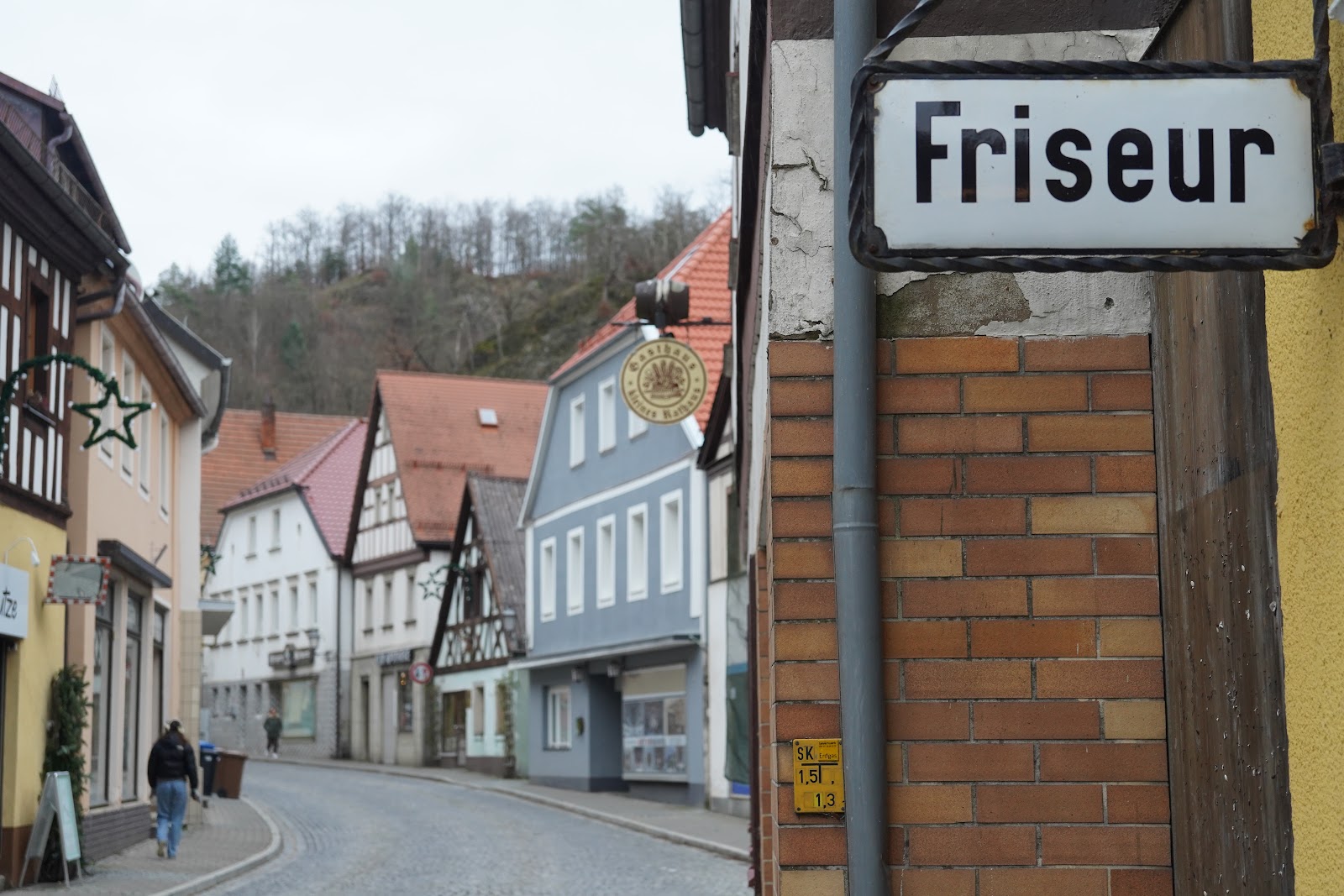
continues into a Bahnhofsstrasse without station
Since the Middle Ages, the area around Bad Berneck, like in the entire Fichtelgebirge, was characterized by small-scale mining, but this soon proved to be no longer economical. Since then, the place has also been able to count Alexander von Humboldt among its famous visitors, who was employed as a Prussian mining inspector in the Fichtel Mountains at the time. With the cessation of mining, an important source of income for the people of Berne disappeared. The place had to reinvent itself.
The historic buildings of the cobbled main street.
.... are overlooked by the rocks of the steep slopes
Rotherstrasse

In the 18th century, the rich elite discovered bathing culture. In many European countries, luxurious seaside resorts emerged where wealthy visitors could imagine that they could improve their poor health with health-promoting mineral water or cures. Some of them were recently declared World Heritage Sites by UNESCO: Baden near Vienna (Austria); Spa (Belgium); Františkovy Lázně; Carlsbad; Mariánské Lázně (Czech Republic); Vichy (France); Bad Ems; Baden-Baden; Bad Kissingen (Germany); Montecatini Terme (Italy); and Bath (UK). Bad Kissingen, Karlovy Vary, Franzensbad and Marienbad are only an hour's drive from Berneck. Its rise since the beginning of the 18th century may also have promoted the idea of developing tourism and a spa in many smaller towns such as Berneck.
Spa park

The first spa operations began in 1830. Since there are no mineral springs in Berneck, they initially resorted to a so-called whey cure. Whey is the residual liquid resulting from cheese production that has a slightly laxative effect. However, the whey cure proved to be medically useless as early as around 1900. In addition to whey, herbs were used for healing applications. First and foremost, Berneck was a climatic health resort.
The old colonnade from 1854 was later moved to the opposite side of the valley
During this time, Berneck had a wealthy sponsor in the cloth manufacturer Wilhelm Rother (1813-1898). When he died, he left the city a foundation of half a million gold marks, which was used to build a spa building, the New Colonnade and the city garden. The bright white, newly renovated new colonnade, built in 1898, still rises above the spa park, opposite the red, old colonnade. It dates from 1854 and was moved to the other side of the river at the Neue. Hohenberneck Castle towers above it. A popular forest swimming pool was also set up at the upper end of the spa park in 1895. The creation of a dendrological garden also goes back to Rother. For those who don't know: Dendrology is the study of woody plants and deals with woody plants, especially trees, shrubs and various climbing plants.
The new colonnade from 1898 is overlooked by Hohenberneck Castle
The history of the Hotel Bube is symbolic of the history of the development of bathing culture in Bad Berneck and the region.
Kneipp treatment pool for treading water
A hotel building was built on Ölschnitz as early as 1852. This part of the hotel, completed in 1884, still exists today. In the same year, 1884, a dining room was added. From 1910, Georg Bube began building a representative new house. Completion was delayed by the First World War and the subsequent global economic crisis, so that the hotel only opened in 1920 as a two-story building with a flat roof. The extension to the current building with two upper floors and a pointed roof was not completed until 1922.
Facade and garden side of the Hotel Bube
The hotel was extremely luxurious for the time. There were 90 rooms with 120 beds available, which were equipped with bathrooms, balconies or loggias, cold and warm water and central heating. In addition to the dining rooms and a beer hall, there were writing, reading and social rooms, terraces, gardens and even what would today be called a wellness area - a Kneipp spa area. There were 20 garages available for the cars of the wealthy guests.
The hotel's historic garages
Kneipp treatments have been carried out in Berneck since 1930. This was followed by a heyday as a sophisticated health resort that attracted prominent guests, sometimes coming from far away. But it was only on November 30, 1950 that the city received the title “Kneipp spa” and only since then was it allowed to call itself “Bad Berneck i. “Fichtelgebirge”.
Abandoned hotels and guesthouses

and abandoned shops
But decline was just around the corner. Officials attribute the decline in visitor numbers to health reforms in the Federal Republic, the closure of the railway line and the effect of reunification on the number of visitors from Berlin.
Many of the guesthouses had gardens or beer gardens
In 1989, reforms were introduced under the leadership of the then Health Minister Norbert Blüm, who was otherwise very socially minded. The deductibles for treatments have actually been increased. But it is questionable whether this actually drove the spas into decline. The decline began much earlier in Bad Berneck. The same applies to the loss of visitors from Berlin. The opening of the border in 1989 came at a time when Bad Berneck had already lost its popularity as a spa resort.
The Hotel Zur Mühle is now the best hotel on the site
Passenger traffic on the Neuenmarkt-Wirsberg – Bad Berneck – Bischofsgrün railway line was stopped on May 26, 1974. It is certain that a large proportion of the bathers were of advanced age and therefore might have chosen to travel by train if there had been an attractive connection. This was probably never the case for Bad Berneck due to the connection via Neuenmarkt-Wirsberg. Even a day visit to nearby Bayreuth by train was a lengthy process. Of course, the bus connection offered as a replacement is still unreasonable, slow and completely unsuitable for older guests with luggage. However, it is also questionable whether it can be seen as a reason for the decline at a time when private transport had priority in every respect.
Historic buildings on the church ring
Abandoned pub

As far as the Hotel Bube is concerned, the decline was already clearly visible before 1989. After Georg Bube's death, the business was continued first by his daughter's family and then by various frequently changing operators. After all, the hotel was closed well before 1989. In the period that followed, Hitler's favorite hostel became a home for asylum seekers, but was no longer used for that purpose after 1997.
Some of the many stairs on the slopes of Berneck
Is anyone else still walking here?
The main reason for the decline of the Fichtelgebirge in general and Bad Berneck in particular as a tourist region is probably a consequence of the changing travel habits of Germans. A region in our own country was no longer good enough for a summer vacation. The Mediterranean countries could be reached easily and inexpensively with your own vehicle. The effect was exacerbated by the constantly falling flight prices. The resulting decline in visitor numbers not only affected the Fichtelgebirge region. When I visited a hotel on the Saarschleife around 2005, I was greeted by the owner with the following words: “What are you doing here when you can easily fly to Mallorca for a long weekend for €99”.

My children took ski courses in the Bischofsgrün winter sports resort around 2003. The ski school there was highly respected at the time because of its methods. The building is now abandoned. Snow is still mainly available as artificial snow. A modern tourist who plans precisely no longer wants to rely on the chance of a rare, harsh winter. Nevertheless, millions in subsidies for new lifts, floodlights and artificial snow systems are being wasted.

There was no lack of attempts to stop the decline. In 1968, a modern indoor swimming pool was built, after which the old river swimming pool in the spa park, which was created from the forest swimming pool from 1895, was closed in 1969. In 2006 it was “temporarily” closed for repairs. What is a spa without a bath? It would have been better to preserve the historic outdoor swimming pool at the upper end of the spa park as a monument. In 1971 a new, so-called Kurmittelhaus was opened. The community couldn't bear that itself either. In private hands it is not very attractive to normal visitors. The historic Art Nouveau Kurhaus was defaced by a horrendous extension. No wonder it's empty today. And on the Anger, the former brewery, which was demolished, was replaced by an abysmally ugly commercial building with a supermarket. Anyone who travels to Bad Berneck now, of course by car, will first see this concrete block, behind which stretches the desolate area of a muddy parking lot full of potholes. For a casual visitor who gets lost here from the nearby B303, this is hardly an invitation to visit the actual town center.
The listed Art Nouveau spa building, which was completely disfigured by a renovation
It wasn't just the Hotel Bube that closed its doors. The enormous Siemens rest home on the hillside above the city has been empty for a long time. Abandoned guest houses are lined up along Bahnhofstrasse. Here and on Rotherstrasse most of the shop windows are empty. As if in mockery, some people still have advertisements for long-distance travel in their dusty shop windows.
(closed) tragfel agency and....
... Shop window wanderlust
The former excursion cafes such as the Waldlust in the Ölschnitztal, and the cafes at Königsstuhl and Wallenrode that hang like bird's nests over the valley are closed or abandoned altogether. Only old postcards bear witness to its former glory. You can no longer expect the typical German tourist to walk from his car to a cafe or climb a mountain himself. The “Berg” on Maintalstrasse, an imposing brick building from 1900, was operated as a guesthouse until 1990, but has been empty since then, boarded up and slowly falling into disrepair. At least it now has monument status and is hopefully safe from demolition.
The former Berg guesthouse, later a hospital and then a guesthouse again
The abandoned Cafe Wallenrode
Although many of the buildings are no longer fully used, the character of the old town center, which nestles up the hillside from Bahnhofsstrasse and Rotherstrasse from the market square towards the church, has largely been preserved. A multitude of winding stair passages connect the few narrow streets. Many of the houses in the town center have the market count style typical of the Bayreuth area. Many things are in poor condition, dilapidated, or empty. There is rubbish in the narrow passages and on the stairs. There is a lack of money everywhere and the general German resignation is doing the rest. It usually doesn't take a lot of money to clean up a backyard.
The baroque Trinity Church...
...is typical of churches from this period in the Margraviate of Bayreuth
The town is crowned by the Trinity Church, which stands on a platform above the town center. The classicist hall building with a hipped roof by Carl Christian Riedel was built between 1796 and 1800. The plateau is bordered by the churchyard wall made of sandstone blocks and stairs. This ensemble is also typical of the area around Bayreuth. The west tower from 1518 used to have an archway as a passage for the Via Imperii.
Former villa of the brewery owner. The space opposite the brewery has become a muddy parking lot

Mansions at the Bärnreuther Bach
Mansions above the former brewery
Der historische Ortskern wird umgeben von historischen Villen aus der Blütezeit der Stadt, die sich über die umliegenden Hanglagen verteilen. Auch hier sind viele verlassen oder in einem renovierungsbedürftigen Zustand. Die resignierten Besitzer haben ihr Geld wohl lieber in der Toskana, in Mallorca oder an der Costa Brava angelegt.
Villas above the former brewery
The town center of Bad Berneck alone has more than 50 protected monuments. It remains to be hoped that this will at least limit further construction sins. The past has left some damage here, not just to the Kurhaus. The small Catholic chapel, also listed, was hidden behind a terrible concrete extension. The town hall is located in a magnificent former school, which is also protected. It has been so defaced by a central entrance building made of concrete and glass that its character has been lost. This disabled access is also incorrectly placed, as most (disabled) visitors probably come from the parking lot at the back of the building rather than from the sidewalk on the busy main street. But the destruction will continue. Buildings from the historic core are torn down and replaced with parking spaces. The completely uninterested Bavarian government even provides subsidies for this.
The facades on the market square were renovated.
But there wasn't enough money for the historic balconies
The Merkel had the best restaurant in Berneck. It is closed

The second building from the left has now had to give way to a parking lot
In addition to its buildings, Bad Berneck still has the beauty of its wild, romantic surroundings. An extensive network of paths has been marked for hikers and cyclists. The Thiesenring, Bad Berneck's home hiking trail, is probably one of the most beautiful and varied hikes in Bavaria, if not Germany. It connects the heights around the city. You visit all the viewpoints, some of which are still decorated with the historic pavilions, pass all of Bad Bernecker's castles and cross some of its rushing mountain streams. You are accompanied by the rugged rock formations of the steep slopes around the city. Wide views of the heights of the Fichtelgebirge alternate with views into the valley of the historic center of the city. And these views are constantly improving due to the enormous forest dieback. “Unobstructed view of the Mediterranean,” comments a hiker about the tree corpses in front of us.
Hiking trails upstream on both sides of the Ölschnitz
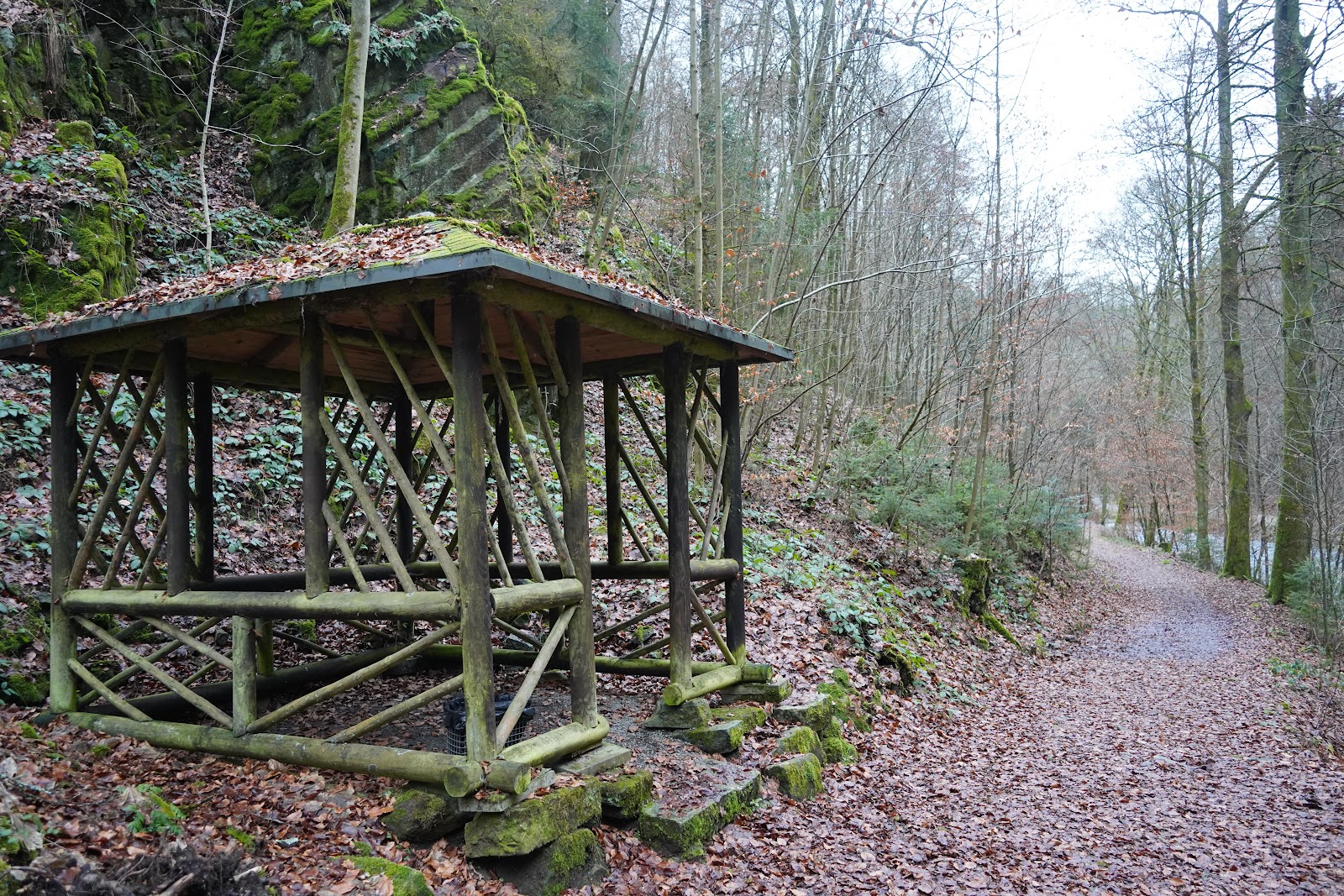
The question remains why the Fichtelgebirge in general and Bad Berneck in particular cannot attract more guests under these conditions. What makes an area like the Bavarian Forest, the Harz or the Elbe Sandstone Mountains more attractive? In the Bavarian Forest it certainly has the status of a national park. In the Harz there is probably the popularity and beauty of cities like Goslar or Wernigerode together with the literary fame of Hexentanzplatz and Brocken. The unreadable Jean Paul can hardly keep up with Goethe. The Elbe Sandstone Mountains have their rocks and the Elbe. Cities like Wunsiedel, Weissenstadt or Bad Berneck do not have the importance of the cities in the Harz Mountains, but they would certainly be attractive from a tourist perspective if more were done to urban development than the unspeakable creation of more parking spaces. The historical significance of the region between Bayreuth, Bohemia and Saxony is completely unknown in the rest of Germany. Just like the rocky landscape around Waldstein, the Steinwald or the Rudolfsteine.
Rock formations in Fichtelgebirge

My neighbors at the restaurant tables will move on tomorrow. Did you learn anything new about the surroundings or history of the place where you spent a night? This wasn't made easy for you. There are no hiking maps anywhere that would inspire you to stay longer. You have to find information about the history on the Internet. The traveler leaves the hotel with the feeling of having just visited one of many more or less pleasant accommodations in an average town.
Granite slab weathering. In the background the Ochsenkopf
Some places in the Fichtelgebirge have also acquired a modest reputation as tourist destinations. Weissenstadt with its lake has managed to attract investors who have built an enormous thermal spa complex. In contrast, the former winter sports resort of Fichtelberg, which also has an attractive lake, is on the verge of turning into a ghost town. Which path will Bad Berneck take?
After the fire in the thermal baths, the town Fichtelberg ...
... degenerated to almost a ghost town
A buyer has now been found who wants to revive the Hotel Bube. The new owners intend to revive its past as a luxury hotel. In a first step, the former dining room was reopened as Buffet Bube. There's not much luxury to be seen there yet. Next, the representative meeting rooms on the ground floor will be available for events. The oldest part of the complex will house regular hotel rooms by the end of next year, while the main building will have luxury suites. New owners have extensively renovated one of the historic buildings on the market square. There are also plans to build condominiums for the former museum. With its proximity to Bayreuth, Bad Berneck would certainly be an attractive residential suburb. However, as long as the Bavarian government doesn't think about giving each of the new residents a BMW to encourage immigration, they might have to think about how the catastrophic bus connection can be improved.
Distant view from the heights above Bad Berneck
Sources
Engelsburg viewpoint on Thiesenring





























